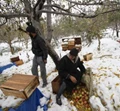
Ghulam Hassan Khan had spent his entire life as an almond farmer. He had inherited a small orchard from his father in Payar village, Pulwama, Jammu and Kashmir. He raised his almond farm and purchased 1,000 high-density apple trees last year due to stagnant prices, declining yields, and skyrocketing input costs.
"Within a year, the return was twice as good as almonds," he said. In and around Pulwama, the story is similar. Traditional Kashmiri almond farmers are abandoning their crop in search of new opportunities. Acres of almond orchards line the road to Payar village. In between are patches of apple trees, some of which are high-density, promising a higher yield per tree.
Almond farming is becoming less viable for a variety of reasons, including increased demand for imported almonds from Iran or Afghanistan, climate change, a lack of irrigation, and the inability to graft (a technique known to aid growth) in almond trees.
An official in Jammu and Kashmir's horticulture department, speaking on the condition of anonymity, stated that the government does not currently have a scheme to assist almond farmers, but is working on one. "Almonds used to be a prime crop in the undulated hilly areas, but this has declined over the years," he said.
Almonds were grown on 9,361 hectares in 1974-75 (the first year for which data is available). This reached a high point in 1994-95, when the crop was grown on 20,222 hectares. In 2015-16, this figure fell to 7,132 hectares. According to department data, almonds were grown on 5,483 hectares in 2020-21.
Meanwhile, India's almond imports have increased by more than threefold. Imports totaled 34.36 thousand metric tonnes in 2008, rising to 115.05 thousand metric tonnes in 2019. According to the latest Foreign Agriculture Service report issued by the United States Department of Agriculture in 2021, India's almond imports increased by 44% between 2019-20 and 2020-2021.
According to farmers, the price of one mann (40 kg) of almonds has remained stable since 2016, at around Rs 6,000-Rs 6,500, while input costs have nearly doubled. They attribute this to a lack of demand. "Imported almonds from Afghanistan and Iran are not only cheaper, but they are larger than Kashmiri almonds." Customers find that more appealing, so they don't buy ours," Khan explained.
"Imported almonds from Afghanistan and Iran are not only cheaper, but they are bigger than Kashmiri almonds. Customers find that more attractive, so they don't buy ours," he added.
He recalled that there was a time when exporters and wholesalers would set up a temporary market near his town every year, where there was fierce competition. This ensured he received the best price for his product. "However, in recent years, very few purchasers have come to Pulwama to purchase almonds.
"A farmer's ability to demand a higher price has been diminished as a result of this," he added. Farmers prefer apples over almonds because government-supported high-density apples are more beneficial to farmers and yield returns in the first year of planting.
According to a horticulture department official, Kashmiri almonds received no attention while almonds from Iran or Afghanistan improved over time. "People chose imported almonds." Farmers' returns have declined over time, so they have cut down the almond trees," he explained.
The official went on to say that the almond plant seedling does not go through grafting, which is a horticulture technique in which plants are tied together through parts like roots and branches so that they aid each other's growth and share nutrients through tissue regeneration. Grafting, a method of vegetative propagation, can treat injured trees, aid in adaptation, and make trees more disease resistant. According to the official, the yield of the almond tree also declines rapidly.
According to the official, Jammu and Kashmir failed to import sufficient planting material. Kashmiri almonds are also "early bloomers," blooming in March-April, coinciding with rains, resulting in flower loss and lower quality fruit due to wind and rain. According to the official, "late bloomers" are needed in the Valley, so that the flower blooms when the weather improves.











